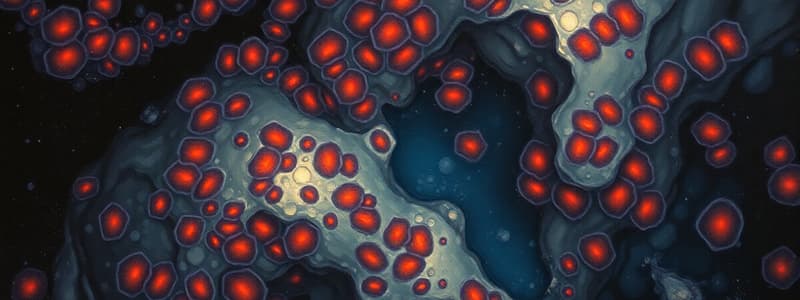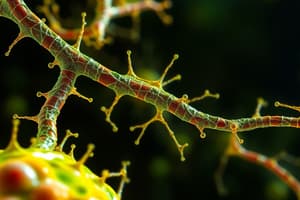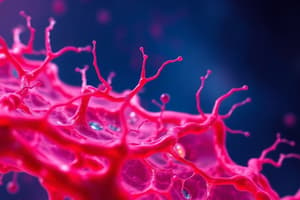Podcast
Questions and Answers
Which of the following best describes the primary function of laminin within the basement membrane?
Which of the following best describes the primary function of laminin within the basement membrane?
- Creating a scaffold for anchoring cells. (correct)
- Regulating the hydration of cartilage tissue.
- Providing tensile strength to the extracellular matrix.
- Facilitating cell-cell communication through gap junctions.
A researcher is studying a sample of connective tissue and notes a high concentration of molecules crucial for resisting compressive forces and maintaining hydration. Which of the following molecules is most likely present in high concentrations?
A researcher is studying a sample of connective tissue and notes a high concentration of molecules crucial for resisting compressive forces and maintaining hydration. Which of the following molecules is most likely present in high concentrations?
- Fibrillar collagen
- Elastin
- Fibronectin
- Hyaluronan and Aggrecan (correct)
A patient is diagnosed with a condition affecting the structural integrity of their skin and blood vessels. Genetic testing reveals a defect in a protein responsible for providing elasticity to tissues. Which of the following proteins is most likely affected?
A patient is diagnosed with a condition affecting the structural integrity of their skin and blood vessels. Genetic testing reveals a defect in a protein responsible for providing elasticity to tissues. Which of the following proteins is most likely affected?
- Elastin (correct)
- Fibrillar collagen
- Fibronectin
- Laminin
In Junctional Epidermolysis Bullosa (JEB), the defect lies within a component of the basement membrane, leading to fragile skin and blistering. Which of the following ECM components is most likely defective in individuals with JEB?
In Junctional Epidermolysis Bullosa (JEB), the defect lies within a component of the basement membrane, leading to fragile skin and blistering. Which of the following ECM components is most likely defective in individuals with JEB?
Which of the following characteristics is associated with laminins?
Which of the following characteristics is associated with laminins?
Which of the following best describes the role of the RGD region found within fibronectin?
Which of the following best describes the role of the RGD region found within fibronectin?
What is the primary function of glycosaminoglycans (GAGs) in the extracellular matrix (ECM)?
What is the primary function of glycosaminoglycans (GAGs) in the extracellular matrix (ECM)?
A patient is diagnosed with a genetic disorder affecting fibrillin. Which of the following symptoms is most likely to be observed in this patient?
A patient is diagnosed with a genetic disorder affecting fibrillin. Which of the following symptoms is most likely to be observed in this patient?
Which type of cell junction provides a direct connection between the cytoskeleton of adjacent cells and is primarily responsible for resisting tensile forces?
Which type of cell junction provides a direct connection between the cytoskeleton of adjacent cells and is primarily responsible for resisting tensile forces?
Cadherins are crucial for cell-cell adhesion in adherens junctions. What key factor is essential for cadherin function in these junctions?
Cadherins are crucial for cell-cell adhesion in adherens junctions. What key factor is essential for cadherin function in these junctions?
A patient presents with severe skin blistering from infancy, leading to scarring and a poor prognosis. Which set of genes, when experiencing a complete loss of function, is most likely implicated in this condition?
A patient presents with severe skin blistering from infancy, leading to scarring and a poor prognosis. Which set of genes, when experiencing a complete loss of function, is most likely implicated in this condition?
What critical role does vitamin C play in the synthesis of non-fibrillar collagen?
What critical role does vitamin C play in the synthesis of non-fibrillar collagen?
What structural characteristic is exclusive to non-fibrillar collagen?
What structural characteristic is exclusive to non-fibrillar collagen?
How do Nidogen and Perlecan contribute to the structural integrity of the extracellular matrix (ECM)?
How do Nidogen and Perlecan contribute to the structural integrity of the extracellular matrix (ECM)?
What is the primary function of integrins in the context of the basement membrane?
What is the primary function of integrins in the context of the basement membrane?
A researcher is investigating the role of different ECM components in tissue organization. If they are studying a proteoglycan that crosslinks type IV collagen and laminin, which molecule are they most likely investigating?
A researcher is investigating the role of different ECM components in tissue organization. If they are studying a proteoglycan that crosslinks type IV collagen and laminin, which molecule are they most likely investigating?
What distinguishes a glycoprotein from a proteoglycan in the context of ECM components?
What distinguishes a glycoprotein from a proteoglycan in the context of ECM components?
Which type of collagen is predominantly found in tendons and ligaments?
Which type of collagen is predominantly found in tendons and ligaments?
What is the role of peptidases in the formation of fibrillar collagen?
What is the role of peptidases in the formation of fibrillar collagen?
A child presents with frequent bone fractures from a young age. Genetic testing reveals a mutation affecting the stability of type I collagen. Which condition is most likely?
A child presents with frequent bone fractures from a young age. Genetic testing reveals a mutation affecting the stability of type I collagen. Which condition is most likely?
In Osteogenesis Imperfecta, mutations in COL1A1 and COL1A2 genes often involve the substitution of glycine with another amino acid. How does this substitution affect collagen?
In Osteogenesis Imperfecta, mutations in COL1A1 and COL1A2 genes often involve the substitution of glycine with another amino acid. How does this substitution affect collagen?
Which of the following tissues relies heavily on elastin's properties to function correctly?
Which of the following tissues relies heavily on elastin's properties to function correctly?
What is the primary function of elastin in the extracellular matrix (ECM)?
What is the primary function of elastin in the extracellular matrix (ECM)?
What is the role of fibrillin in relation to elastin?
What is the role of fibrillin in relation to elastin?
Marfan Syndrome is associated with mutations in the FBN1 gene. What direct effect does this have on connective tissue?
Marfan Syndrome is associated with mutations in the FBN1 gene. What direct effect does this have on connective tissue?
A patient is diagnosed with Marfan Syndrome due to a mutation in the FBN1 gene. Which aspect of connective tissue is most directly affected by this mutation?
A patient is diagnosed with Marfan Syndrome due to a mutation in the FBN1 gene. Which aspect of connective tissue is most directly affected by this mutation?
How does the structural arrangement of collagen and elastin differ in providing mechanical support to tissues?
How does the structural arrangement of collagen and elastin differ in providing mechanical support to tissues?
Flashcards
Extracellular Matrix (ECM)
Extracellular Matrix (ECM)
A network of macromolecules outside cells that provides structural and biochemical support to surrounding cells.
Basement Membrane
Basement Membrane
One layer of the ECM; contains laminin, non-fibrillar collagen, integrin, nidogen, and perlecan.
Laminin
Laminin
A family of proteins that form a scaffold by self-assembling into polymers in the presence of calcium.
Interstitial Matrix
Interstitial Matrix
Signup and view all the flashcards
Junctional Epidermolysis Bullosa (JEB)
Junctional Epidermolysis Bullosa (JEB)
Signup and view all the flashcards
LAMA3, LAMB3, LAMC2
LAMA3, LAMB3, LAMC2
Signup and view all the flashcards
Laminin loss of function
Laminin loss of function
Signup and view all the flashcards
Non-Fibrillar Collagen
Non-Fibrillar Collagen
Signup and view all the flashcards
Glycine-Proline-Hydroxyproline
Glycine-Proline-Hydroxyproline
Signup and view all the flashcards
Vitamin C
Vitamin C
Signup and view all the flashcards
Integrins
Integrins
Signup and view all the flashcards
Nidogen and Perlecan
Nidogen and Perlecan
Signup and view all the flashcards
Fibrillin Mutation
Fibrillin Mutation
Signup and view all the flashcards
Fibronectin
Fibronectin
Signup and view all the flashcards
Glycosaminoglycans (GAGs)
Glycosaminoglycans (GAGs)
Signup and view all the flashcards
Adherens Junctions
Adherens Junctions
Signup and view all the flashcards
Desmosomes
Desmosomes
Signup and view all the flashcards
Fibrillar Collagen Function
Fibrillar Collagen Function
Signup and view all the flashcards
Type I Collagen Location
Type I Collagen Location
Signup and view all the flashcards
Type II Collagen Location
Type II Collagen Location
Signup and view all the flashcards
Type III Collagen Location
Type III Collagen Location
Signup and view all the flashcards
Osteogenesis Imperfecta
Osteogenesis Imperfecta
Signup and view all the flashcards
OI Implicated Genes
OI Implicated Genes
Signup and view all the flashcards
Elastin Function
Elastin Function
Signup and view all the flashcards
Elastin Location
Elastin Location
Signup and view all the flashcards
Fibrillin's Role
Fibrillin's Role
Signup and view all the flashcards
Marfan Syndrome
Marfan Syndrome
Signup and view all the flashcards
Study Notes
- Extracellular matrix
- BMS 531 – FEBRUARY 17TH, 2025
- Recommended reading: Lippincott® Illustrated Reviews: Cell and Molecular Biology, 3e - Chapter 2
Learning Objectives
- Understand the general structure of the ECM and identify the macromolecules within the two important layers.
- Define the structure and function of key ECM components: laminin, non-fibrillar collagen, integrin, nidogen, perlecan, fibrillar collagen, fibronectin, elastin, and glycosaminoglycans.
- Explain the structure and function of hyaluronan and aggrecan, and identify their role in cartilage structure.
- Compare and contrast the different types of cellular junctions in terms of location, function, and important adhesion molecules.
- Recognize the clinical presentation of diseases associated with the ECM and cellular junctions, identifying the defective component.
Structure of the ECM
- The ECM consists of the Basement Membrane and the Interstitial Matrix
Basement Membrane (Basal Lamina)
- Composed of Laminin, Non-Fibrillar Collagen, Integrin, Nidogen, and Perlecan
Connective Tissue (Interstitial Matrix)
- Consists of Fibrillar Collagen, Fibronectin, Elastin, Hyaluronic Acid, and Proteoglycans
Laminins
- These are a large family of proteins.
- Each is composed of three polypeptide chains (α, β, and y).
- Disulfide bonds create the characteristic cross shape, enabling self-assembly into polymers in the presence of calcium.
- Structural differences based on cell type reflect varied ECM functions.
- Laminins create a scaffold for anchoring cells.
Clinical Correlation: Junctional Epidermolysis Bullosa (JEB)
- This condition features an Autosomal recessive inheritance.
- Implicated genes include LAMA3, LAMB3, and LAMC2.
- Complete loss of laminin function leads to a more severe phenotype.
- Patients present in infancy/childhood with blistering of the skin that heals with scarring.
- The prognosis is very poor and often fatal.
Non-Fibrillar Collagen
- This is composed of type IV collagen, featuring a triple helix structure held together by hydrogen bonds.
- Each chain consists of repeating units of glycine-proline-hydroxyproline.
- Hydroxylation of proline requires vitamin C.
Integrin, Nidogen, and Perlecan
- Integrins are components of hemidesmosomes, which are involved in linking a cell's epithelium to laminin within the basement membrane.
- Nidogen links with type IV collagen and laminin.
- Perlecan is a proteoglycan involved in crosslinking type IV collagen and laminin.
Fibrillar Collagen
- These are secreted by fibroblasts.
- They are composed of collagen types I, II, III, and V.
- Type I is present bones, tendons, and ligaments.
- Type II is present in cartilage and intervertebral discs.
- Type III is present in skin and blood vessels.
- Fibroblasts secrete pro-peptides, which are then cleaved by peptidases to assemble into fibrils.
- They provide strength to connective tissue and aid in the formation of interchain crosslinks.
Clinical Correlation: Osteogenesis Imperfecta (OI)
- This condition features an autosomal dominant inheritance and is caused by mutations in genes COL1A1 and COL1A2.
- Mutations that change glycine to a different amino acid can affect type I collagen stability and fibril formation.
- Patients present at a young age with frequent fractures that may be misdiagnosed as child abuse.
- "brittle bone disease"
Elastin
- Found in the interstitial matrix/CT layer, it provides flexibility to the ECM, which is otherwise inelastic due to collagen.
- It is highly expressed in the lungs, blood vessels, and skin.
- Individual elastin molecules covalently cross-link to form elastin structure.
- Elastin is surrounded by fibrillin, which scaffolds for elastin deposition.
- It permits stretch and recoil of tissues subject to mechanical strain and deformation.
Clinical Correlation: Marfan Syndrome
- This has a Autosomal dominant inheritance.
- The implicated gene is FBN1.
- Mutations in fibrillin affect elastin fibril integrity, decreasing strength.
- Patients present with bone overgrowth, loose joints, abnormally long extremities and face, and may develop cardiovascular defects.
- Common condition.
Fibronectin
- This is present in the interstitial matrix/ CT layer.
- Fibronectin consists of polypeptide dimers that are linked at their C-terminus via disulfide bonds.
- Different binding regions attract various ECM and cellular proteins.
- The RGD region is responsible for integrin binding.
- Fibronectin attaches the basement membrane to connective tissue.
- It is also involved in cell migration.
Glycosaminoglycans (GAGS)
- GAGS features Covalently-linked repeating disaccharides
- Sugar 1 includes Glucuronic/Iduronic acid OR galactose.
- Sugar 2 includes N-acetylglucosamine OR N-acetylgalactosamine.
- It forms the gelatinous texture of the ECM.
- Examples:
- Hyaluronan, composed of glucuronic acid and N-acetylglucosamine, can withstand compressive forces.
- Aggrecan, composed of chondroitin and keratan sulfate assembles with hyaluronan to form large aggregates in cartilage.
Cell-Cell and Cell-ECM Adhesions
- These include Anchoring Junctions, Tight Junctions, and Gap Junctions.
Anchoring Junctions
- These connect cells to each other (cell-cell adhesions) or to the underlying ECM (cell-ECM adhesions).
- Cell-cell adhesions include Adherens Junctions and Desmosomes.
- Cell-ECM adhesions include Focal Adhesions and Hemidesmosomes.
Cell-Cell Adhesions
- Adherens Junctions form Cellular Adhesion Molecules (Cadherins):
- E-cadherins, P-cadherins, and N-cadherins which is dependent on calcium for function.
- It's Attaches to cytoskeleton via adapter proteins and attaches to actin filaments.
- Desmosomes attach to Desmosomal Cadherins and intermediate filaments.
Cell-ECM Adhesions
- Uses Integrins as Cellular Adhesion Molecule
- It attaches to either actin filaments (focal adhesions) or intermediate filaments (hemidesmosomes.)
- The function for both types of Cell adhesions are to determine shape, allows signaling, for force transmission, cell movement and rigidity
Clinical Correlation: Bullous Pemphigoid
- This is an autoimmune condition vs genetic.
- Autoantibodies generated against BP180/type XVII collagen and BP230 disrupt the normal structure of hemidesmosomes.
- The patient presents with severe blistering and inflammation.
- It can be countered with immunosuppressants (corticosteroids)
Tight Junctions and Gap Junctions
- Tight Junctions are Located towards the apical side of cells.
- They prevent unregulated vertical movement of molecules between cells and allow for movement of certain small molecules and ions (paracellular transport).
- Gap Junctions include connexins. Six subunits in one cell plus six more in another create a pore between adjacent cells.
- Gap Junction creates channels for movement of inorganic ions and water-soluble molecules between two cells.
Studying That Suits You
Use AI to generate personalized quizzes and flashcards to suit your learning preferences.



